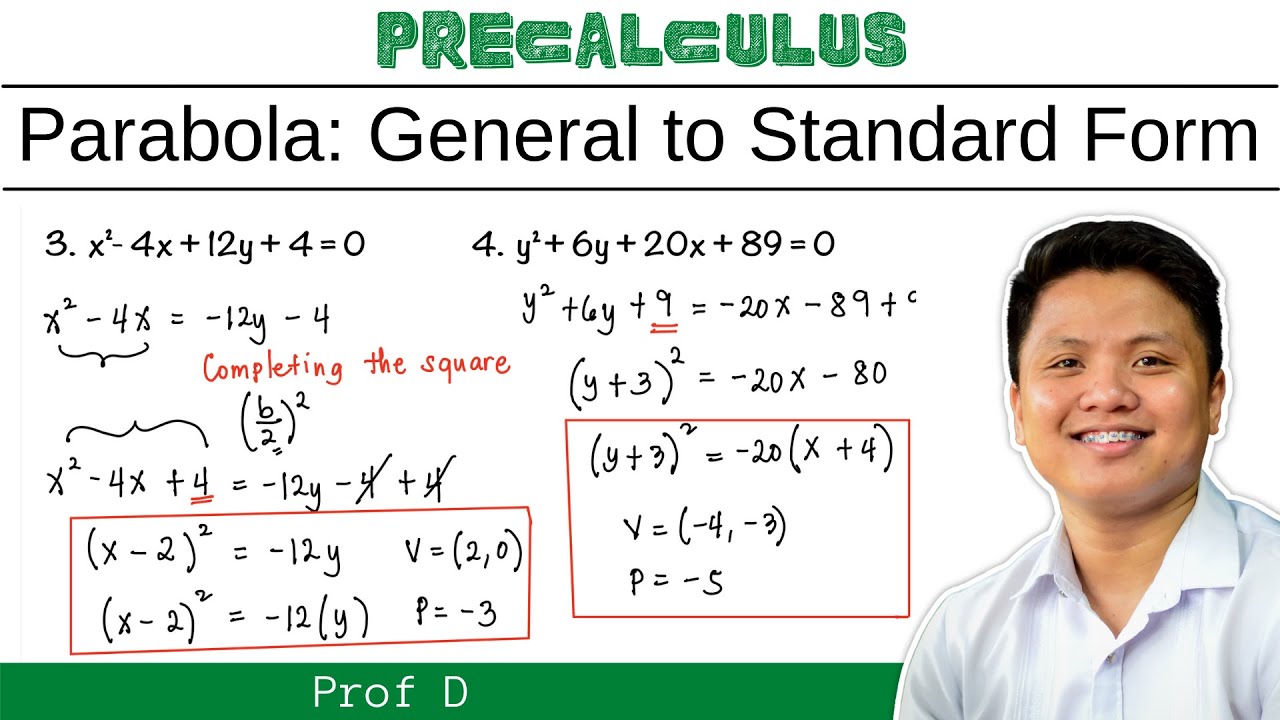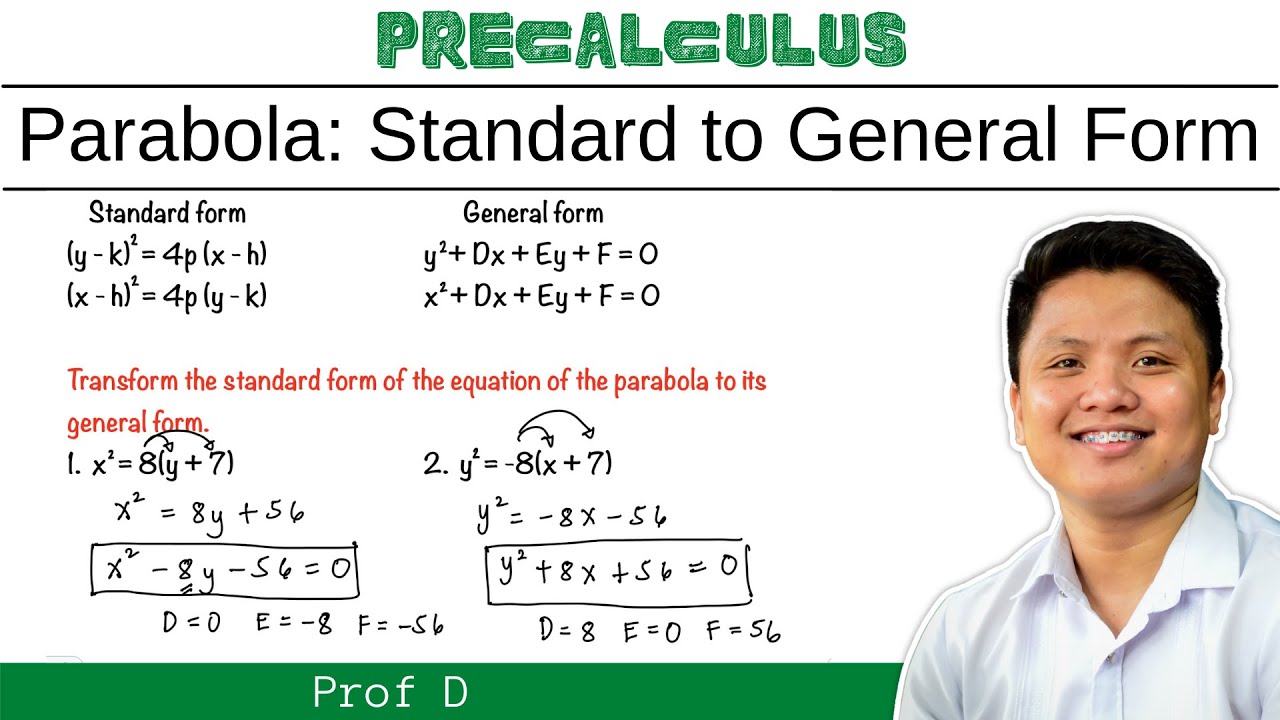Writing Equation of A Parabola in Standard and General Form | @ProfD
TLDRThis educational video tutorial demonstrates how to derive the equation of a parabola in general form based on given conditions. The instructor starts by explaining the process using the vertex and focus of a parabola, calculating the value of 'p' to form the equation. The video then provides a step-by-step guide to simplify the equation into standard form and eventually into general form. A second example is given involving the vertex and directrix, further illustrating the method to find the parabola's equation. The host, Prof D, encourages viewers to ask questions in the comments for further clarification.
Takeaways
- 📚 The video is an educational tutorial on how to write the equation of a parabola in general form based on given conditions.
- 📐 The first example discusses a parabola with a vertex at (-2, 3) and a focus at (-4, 3), indicating the parabola opens to the right.
- 🔍 The formula \( (y - k)^2 = 4p(x - h) \) is introduced to derive the equation of a parabola given its vertex and focus.
- 📈 The value of 'p' is calculated by using the focus coordinates, leading to the equation \( y - 3^2 = 4(-2)(x - (-2)) \).
- 🧩 The equation is simplified to \( y - 3^2 = -8(x + 2) \) and then rearranged to the general form \( y^2 - 6y + 9 = -8x + 16 \).
- 📉 The second example features a parabola with a vertex at (3, -5) and a directrix given by the line \( y + 8 = 0 \), suggesting the parabola opens upwards.
- ✂️ The directrix equation \( y = -8 \) is used to find 'p', resulting in the standard form equation \( (x - 3)^2 = 4(3)(y + 5) \).
- 🔢 After expanding and rearranging, the general form of the second parabola's equation is derived as \( x^2 - 6x - 12y - 51 = 0 \).
- 👨🏫 The presenter, Prof D, provides step-by-step instructions and explanations for each step in the process.
- 💬 The video encourages viewers to ask questions or seek clarifications in the comment section below.
Q & A
What is the general form of the equation of a parabola?
-The general form of the equation of a parabola is y = ax^2 + bx + c, where a, b, and c are constants.
What are the coordinates of the vertex given in the first example?
-The vertex is at (-2, 3).
What is the focus of the parabola in the first example?
-The focus is at (-4, 3).
How is the value of 'p' determined in the first example?
-The value of 'p' is determined by using the formula p = h + k, where h and k are the coordinates of the vertex and focus, respectively. In this case, p = -2 + (-2) = -4.
What is the standard form of the equation of the parabola in the first example?
-The standard form is (y - k)^2 = 4p(x - h), which simplifies to y - 3^2 = 4(-2)(x - (-2)).
How do you convert the standard form equation to the general form in the first example?
-You expand the binomial and combine like terms. In this case, it becomes y^2 - 6y + 9 = -8x + 16, which simplifies to y^2 + 8x - 6y + 25 = 0.
What is the vertex of the parabola in the second example?
-The vertex is at (3, -5).
What is the equation of the directrix in the second example?
-The equation of the directrix is y + 8 = 0, which simplifies to y = -8.
How is the direction of the parabola's opening determined?
-The direction is determined by the sign of 'a' in the general form of the equation (y = ax^2 + ...). If 'a' is positive, the parabola opens upward; if 'a' is negative, it opens downward.
How do you find the value of 'p' using the directrix in the second example?
-The value of 'p' is found by setting the y-value of the directrix equal to k - p, where k is the y-coordinate of the vertex. Solving for p gives p = k + y_directrix, which is p = -5 + 8 = 3.
What is the general form of the equation of the parabola in the second example?
-The general form is x^2 - 6x - 12y + 9 - 60 = 0, which simplifies to x^2 - 6x - 12y - 51 = 0.
What is the significance of the directrix in the context of a parabola?
-The directrix is a line that is equidistant from every point on the parabola to the focus, and it is used to determine the orientation of the parabola.
Outlines
📐 Introduction to Writing the Equation of a Parabola
The video begins with a welcome to the channel and an introduction to the topic: writing the equation of a parabola in general form. The example given is a parabola with a vertex at (-2, 3) and a focus at (-4, 3). The explanation details how to determine the equation based on these conditions, including identifying the vertex and focus, and understanding the parabola's direction of opening. The key formula y - k squared = 4p(x - h) is introduced, and the process of finding p is demonstrated. The calculations lead to the equation in standard form and ultimately converting it to the general form.
📝 Simplifying and Solving Parabola Equations
This section explains how to simplify the equation and convert it into general form. The process includes expanding the binomial y - 3 squared and distributing terms. The equation is rearranged to get all terms on one side, resulting in y^2 + 8x - 6y + 25 = 0. This part also sets the stage for a second example involving a different set of conditions: a vertex at (3, -5) and a directrix y + 8 = 0. The values of h and k are identified, and the equation of the parabola that opens upward is developed step-by-step, solving for p using the directrix.
📊 Converting to General Form and Conclusion
The final paragraph covers the conversion of the second example's equation to general form. The steps include expanding the binomial x - 3 squared and distributing terms to form the general equation x^2 - 6x - 12y - 51 = 0. The video concludes with a recap and an invitation for viewers to ask questions or leave comments. The speaker signs off, thanking viewers for watching and promising more content in future videos.
Mindmap
Keywords
💡Parabola
💡Vertex
💡Focus
💡Directrix
💡Equation
💡General Form
💡Standard Form
💡Simplifying
💡Binomial
💡Expanding
💡Combining Like Terms
Highlights
The video teaches how to write the equation of a parabola in general form that satisfies given conditions.
The first example has the vertex at (-2, 3) and focus at (-4, 3).
Since the focus is not at the vertex, the parabola opens upwards.
The general form equation is derived using the vertex and focus coordinates.
The focus formula h + p = (-4, 3) is used to solve for p.
Solving for p gives p = -2, so the vertex form is y - 3^2 = 4p(x - h).
Simplifying gives the standard form y - 3^2 = -8(x - 2).
Expanding and rearranging terms results in the general form y^2 + 8x - 6y + 25 = 0.
The second example has the vertex at (3, -5) and directrix y + 8 = 0.
The parabola opens upwards since it never touches the directrix.
The directrix formula y = k - p is used to solve for p.
Solving gives p = 3, so the vertex form is x - h^2 = 4p(y - k).
Simplifying gives the standard form x - 3^2 = 12(y - (-5)).
Expanding and rearranging terms results in the general form x^2 - 6x - 12y + 9 - 60 = 0.
The final general form equation of the parabola is x^2 - 6x - 12y - 51 = 0.
The video provides a step-by-step process for deriving the parabola equation from given points.
Two examples with different conditions are worked out in detail.
The focus and directrix formulas are used to solve for the unknown parameter p.
The vertex form is simplified to the standard form by substituting the known values.
The general form is obtained by expanding and rearranging terms from the standard form.
Combining like terms is crucial in obtaining the final general form equation.
The video concludes with a summary of the steps and the final general form equation.
Transcripts
Browse More Related Video

How to find the equation of a parabola given vertex and directrix | @ProfD

Transforming General Form to Standard Form of Parabola | @ProfD

How To Find The Vertex of a Parabola - Standard Form, Factored & Vertex Form

Parabola Equation Grade 11 | Grade 11 Functions

STANDARD EQUATION OF PARABOLA TO GENERAL FORM

Transforming Standard Form to General Form of Parabola | @ProfD
5.0 / 5 (0 votes)
Thanks for rating: